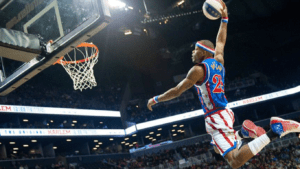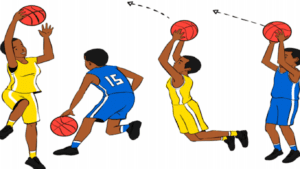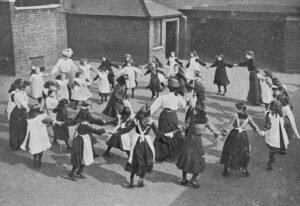Introduction:
Since its late 19th-century founding old fashioned basketball attempts nyt has changed greatly. Rule changes as well as athlete styles and approaches have occurred. In old-fashioned basketball, fans and historians romanticize teamwork, core abilities, and smart moves over showy athleticism. This article examines retro basketball skills, player roles, and cultural effects.
The Origins of Basketball

Springfield Massachusetts physical education teacher Dr. James Naismith created basketball in December 1891. Naismith wanted to create a winter indoor game. The original game included a peach basket goal and a soccer ball which presented distinct obstacles and tactics. Early basketball was non-dribbling; players passed the ball while stationary. This constraint promoted collaboration and precision passing creating the groundwork for old-fashioned playing techniques.
The Fundamental Techniques of Retro Basketball

Passing
Passing is a basic old fashioned basketball attempts nyt ability. Early on players depended on passing to advance the ball up the court and score. The chest pass bounce pass and overhead pass let the ball reach its goal precisely. Teams could sustain possession and tactically position players for maximum shooting possibilities with these passing strategies. Bob Cousy and Bill Russell showed how passing might destroy defenses.
Shooting
Retro basketball also had a different shooting style. Players preferred set shots over jump shots which dominate today’s game. Set shots emphasize precision over force by requiring players to stand still and shoot. This method was successful in the early days when three-point shooting was nonexistent and the emphasis was on high-percentage attempts closer to the basket. Jerry West and Wilt Chamberlain had this shooting approach combining basic mechanics with time and location.
Defense
Old-school old fashioned basketball attempts nyt defenses centered on man-to-man coverage. Coaches instructed players to remain close to their opponents and anticipate passes and shots using body placement and lateral movement. This defense required physical talent, game knowledge, and the ability to read opponents’ moves. The notion of “help defense” when players aid each other and defend opponents also evolved during this period emphasizing togetherness on the court.
Evolution of Playing Styles Through the Decades

The 1940s: The Birth of Professional Basketball
The BAA and NBA were founded in the 1940s starting professional basketball. Players started using more planned attacking and defensive techniques. Teams played more strategically by exploiting defensive flaws. As players realized that collaboration frequently outperformed individual skills teamwork became even more important.
The 1960s: The Rise of the Fast Break
Fast Break a breakthrough attacking approach from the 1960s stressed speed and transition. This strategy helped Bill Russell and Bob Cousy’s Boston Celtics dominate the league. Fast break ball movement and defense-to-offense transitions allowed teams to score easy baskets before the opposition’s defense set up. This change in style showed how agility and rapid decision-making were becoming more important in basketball while respecting prior talents.
The 1970s: The Era of Individual Talent
Skilled and athletic players emerged in the 1970s. Julius Erving and Kareem Abdul-Jabbar’s brilliance frequently overshadowed the preceding styles’ underlying qualities. This age was more individualistic with players using their athleticism to create plays. However, teams still valued collaboration and communication combining individual skills with collaborative plans to succeed on the court.
Cultural Impact of Old Fashioned Basketball

The Role of Basketball in American Culture
In American culture, basketball has long been a tool for social reform community development, and entertainment. Films and documentaries glorify old-fashioned old fashioned basketball attempts nyt and aim to show the sport’s rich history and capacity to unify disparate groups. Each decade brings cultural technological and athletic advancements to the game.
Legends of the Game
Michael Jordan and Larry Bird emphasize basics in their sports. Fundamental talents may lead to greatness as shown by these players. Their tales inspire newer players to work hard be dedicated and know the game well. Modern musicians combine old and new approaches influenced by these luminaries.
Nostalgia and Retro Basketball
Retro basketball styles are valued for nostalgia. Old-fashioned basketball’s simplicity and collaboration are romanticized by fans. Because of this nostalgia vintage leagues and tournaments have returned so players may enjoy the game as intended. These activities honor basketball’s rich heritage and promote essential skills.
Conclusion:
Old-fashioned basketball tries to reveal the sport’s history and changing trends. Understanding vintage basketball’s strategies and culture helps us appreciate its core talents that still shape the game. Past teachings remind players and spectators of the value of cooperation talent and strategy in basketball success as it grows.
FAQs
What defines “old-fashioned” basketball?
Old-fashioned basketball refers to the original methods and tactics utilized from the late 19th century to the mid-20th century. It stresses passing shooting and collaboration above contemporary basketball’s athleticism and showy maneuvers. This generation relied on set shots clever passing and man-to-man defense.
How did the rules of basketball evolve?
Basketball rules have evolved significantly since Dr. James Naismith first devised the game. Early rules prohibited dribbling requiring players to pass the ball instead. Over time dribbling became a key part of the game with the introduction of new rules governing ball-handling fouls and scoring. The three-point line shot clock and changes to fouling rules have further shaped how basketball is played today.
Who were some of the key players in old-fashioned basketball?
Bill Russell Bob Cousy Jerry West and Wilt Chamberlain were old-school basketball players. These sportsmen improved the game’s strategy and mastered basic tactics. Their abilities and achievements shaped basketball throughout their periods affecting subsequent players.
Why is teamwork emphasized in retro basketball?
Retro basketball relied on teamwork above individual ability. Effective communication accurate passing and collaborative strategy were crucial for team success as dribbling was less valued. Players worked together to score showing that success requires teamwork.



